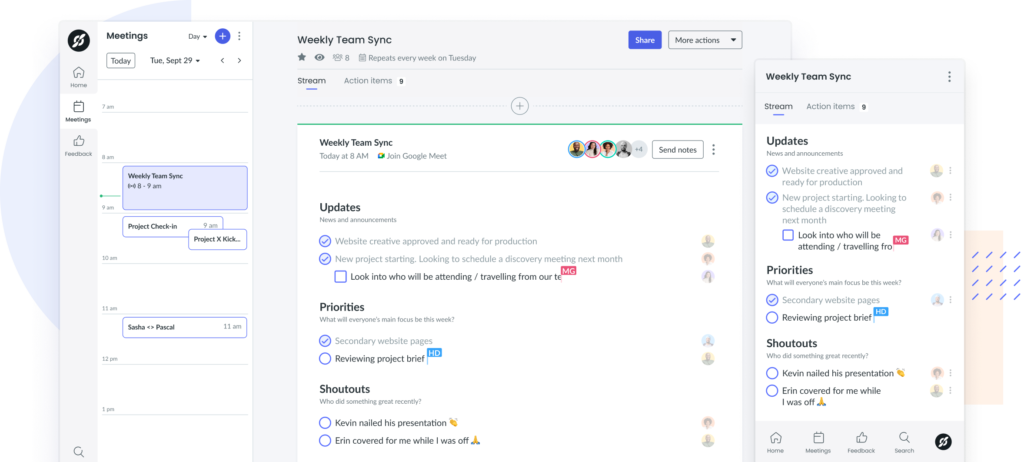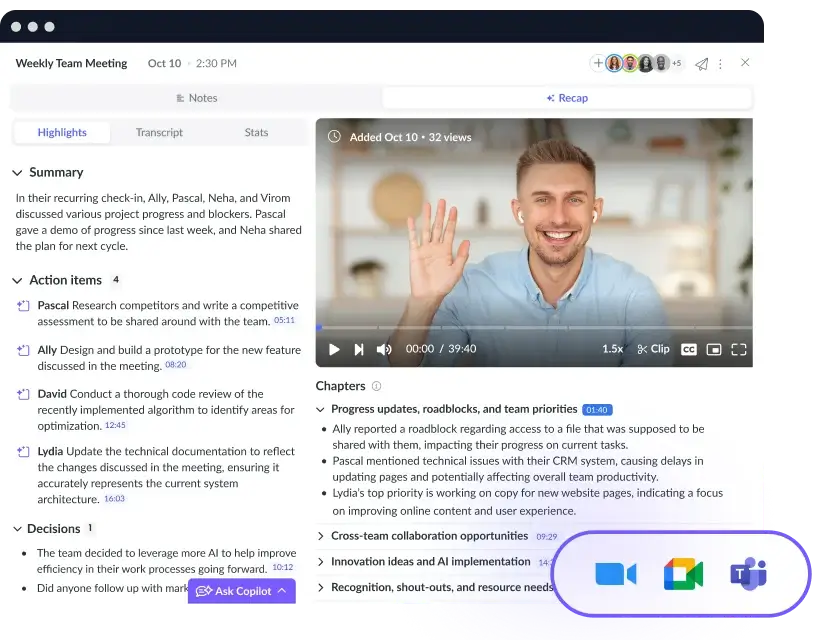Departmental Meetings: Everything you Need to Know
Departmental meetings promote alignment, inclusion and engagement. Check out how to execute them successfully.
In many organizations, several teams compose a department and so it’s very important to make time for departmental meetings, which is an opportunity to be collaborative and to provide critical company updates. Departmental meetings are a type of team meeting to go over team goals, news, updates, obstacles and to strategize next steps. A department meeting ensures alignment across one or several teams and creates a space to problem-solve collectively, to learn, and progress as a group.
Because it’s important to know how to conduct a departmental meeting, Fellow has put together this article which covers what a departmental meeting is, why they’re so important, the structure this type of meeting should take, along with common challenges that teams experience. If you’re not one hundred percent sure how to run a department meeting, this article is for you.
- What is a departmental meeting?
- Why are departmental meetings important?
- Departmental Meeting Structure
- Common challenges of departmental meetings
- Free departmental meeting agenda templates
What is a departmental meeting?
A departmental meeting is not an educational meeting or seminar. It is specifically for a given department within an organization. Examples of departmental meetings may include:
- Marketing department meeting
- Sales department meeting
- Engineering department meeting
- Customer Success department meeting
- Etc!
The purpose of the departmental meeting should be decided based on the topics of the agenda and the overarching organizational goals of the business. An effective department meeting creates alignment among team members, gives space to air concerns or issues that arise, and provides clarity on next steps.
It’s important that you and your team decide on a purpose for your meeting that is the most pressing and pertinent at the time. It’s a great idea to ask for input from your department on what they feel is the most important to discuss.
Conducting departmental meetings improves wellness because they foster an open environment for discussion, which is a good opportunity to strengthen relationships and to collaborate. What’s more is that departmental meetings reinforce the company’s mission, vision, and values.
Why are departmental meetings important?
1 How do they improve the department?
Departmental meetings are important for a few reasons. Firstly, they improve the department by creating an opportunity to communicate openly with the entire department in the same room, so that everyone can be on the same page. When you take the time to improve communication, work more efficiently with your team members, your productivity will also improve. A positive department meeting boosts morale, lowers staff stress, and encourages engaging conversations. Ensuring that these meetings occur on a consistent basis is going to lead to well-informed and more productive employees.
2 What are the effective outcomes?
- Stronger communication
- Better team alignment
- More alignment
- Higher performance
- Better productivity
The effective outcomes of meetings are stronger alignment, stronger performance, and a great opportunity to both teach and learn. These are the types of meetings and discussions that are going to give employees the information and tools they need to perform their best. Departmental meetings are one of the most efficient ways of strengthening team communications, efficiency, and productivity.
It’s important to set the desired outcome of your department meeting in advance so that you can get the most out of your time.
Departmental Meeting Structure
1 Opening, introductions
It’s important to dedicate a portion at the beginning of your department meeting for a proper opening and take the time for introductions. Not everyone within a department always has the opportunity to work together, which is why it’s essential to go around the table (whether this is in person or virtually) and to have everyone introduce themselves.
2 Department updates
Your department meeting is the perfect opportunity to go over any company updates that have taken place since the last meeting. Use the meeting to discuss major developments, project progress, to highlight good news, and to give the entire department some feedback. If there have been any kinds of administrative or organizational changes within the department, this is a great opportunity to bring this to light as well.

Pro tip
Use a meeting management tool like Fellow to document any important updates, feedback, and more so attendees can easily recall the conversation.

3 Goals/Metrics
After setting goals, it’s important to provide metric updates to the department so that you can track your productivity and understand what is required to achieve your business goals. Updating the department about whether you’re on track with your goals will help the team prioritize tasks and focus on what matters most.
4 Q&A
Include time in your department meeting agenda for your team members to ask questions and yield answers. Employees are going to feel more seen and heard when they are given dedicated time to clarify any questions they may have, without feeling rushed or as if they are holding their colleagues past the meeting end time. This dedicated time says that employees’ thoughts, questions, and contributions are valuable.
5 Closing on a positive note
Choosing to close your department meeting on a positive note is going to keep your team members engaged. This is going to leave you and your colleagues feeling energized and motivated even after the meeting has come to a close. The most valuable part is that ending each meeting on a positive note is a great way to bring your team closer together and build a stronger team morale.
Common challenges of departmental meetings (and how to handle them!)
Speed and efficiency
Challenge: It’s tough to get the entire department together without going way over on the meeting time. Often, the speed of the meeting gets significantly slowed down and the team can’t be as efficient as you’d like to be because the discussion is too disorganized.
Solution: Make sure that your meeting agenda outlines specific time slots for each agenda item so that you can make sure that you don’t go overtime and so that you can remain as efficient as possible.
Egos
Challenge: If there are a few egos in the room, chances are they would like to speak and to be heard. This becomes an issue when many individuals feel they have important remarks to make and these discussion points aren’t included in the meeting agenda.
Solution: It’s a great idea to assign speakers to different sections of the agenda. Collaborate in advance to see which team members would like to contribute to which sections of the meetings and make sure to be inclusive of all voices. If someone is speaking off-topic from the agenda, jot it down and get back to the meeting agenda as your meeting guide.
Poor management
Challenge: Poor management is typically a result of poor organization. Disorganization is going to lead to unproductive meetings. If there is no one specifically assigned to facilitating the meeting, there’s likely no one in charge of getting a meeting agenda out to the department. With no agenda, it’s not likely that meeting minutes will record the conversation.
Solution: You or someone you assign should be in charge of facilitating the department meeting. Whoever is facilitating is also in charge of circulating a meeting agenda and asking for the contributions of other team members.
Derailed Conversation
Challenge: Often when there are many meeting participants, the conversation can become easily derailed. With many meeting attendees come many thoughts and opinions that individuals want to share. If the conversation is often being derailed, it’s going to become very difficult to hit the goal(s) of the meeting.
Solution: Creating a meeting agenda in advance is going to keep your conversation on track. When you do accidentally get off track, you can use your meeting agenda to bring you back to the focus of the conversation.
Endless discussion on one topic
Challenge: Sometimes there is a particular topic that changes often, poses issues or challenges, and seems to be an ongoing battle. These are the types of discussion points that can become dangerous because it seems they can be discussed until the cows come home! By focusing on this one area, you’re neglecting the rest of the meeting.
Solution: Assigning time slots to each agenda item will help you and your team stick to the time that was assigned to that specific item. If there needs to be further discussion on a particular topic, it can be brought up at a later time, whether it’s through an email or another more focused meeting.
Parting advice
A department meeting is an effective way to make sure that your employees and management teams are aligned, that no obstacles stand in the way of your organizational progress, and to create an open environment for collaboration. Begin with solidifying a purpose for your departmental meeting. Next, build out a meeting agenda and circulate it to the rest of the department for their input and suggestions. Create time slots for each agenda item and don’t forget to leave some time for questions and answers at the end of the meeting. Lastly, make your departmental meeting recurring so that you and your team can continue to solidify your communication skills and work towards your organizational goals.











